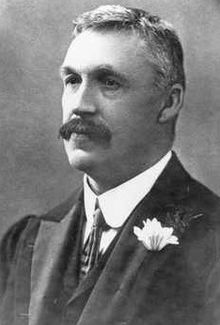Archibald Peake
Archibald Peake | |
|---|---|
 | |
| 25th Premier of South Australia | |
| In office 5 June 1909 – 3 June 1910 | |
| Monarchs | Edward VII George V |
| Governor | Sir Day Bosanquet |
| Preceded by | Thomas Price |
| Succeeded by | John Verran |
| In office 17 February 1912 – 3 April 1915 | |
| Monarch | George V |
| Governor | Sir Day Bosanquet Sir Henry Galway |
| Preceded by | John Verran |
| Succeeded by | Crawford Vaughan |
| In office 14 July 1917 – 6 April 1920 | |
| Monarch | George V |
| Governor | Sir Henry Galway |
| Preceded by | Crawford Vaughan |
| Succeeded by | Henry Barwell |
| Leader of the Opposition in South Australia | |
| In office 3 June 1910 – 17 February 1912 | |
| Preceded by | John Verran |
| Succeeded by | John Verran |
| In office 3 April 1915 – 14 July 1917 | |
| Preceded by | Crawford Vaughan |
| Succeeded by | Crawford Vaughan |
| Member of the South Australian House of Assembly | |
| In office 22 May 1897 – 6 April 1920 | |
| Constituency | Albert (1897–1902) Victoria and Albert (1902–1915) Alexandra (1915–1920) |
| Personal details | |
| Born | Archibald Henry Peake 15 January 1859 Liberal Union Independent |
Archibald Henry Peake (15 January 1859 – 6 April 1920) was an Australian
Early life and career
Peake's family migrated from
Parliamentarian

Peake was elected to the South Australian House of Assembly as the Member for Albert[1] representing Naracoorte. After his election, Peake was at first an independent supporting the Liberal Governments of Charles Kingston and Frederick Holder. He became disillusioned with the Government of John Jenkins leading him to become leader of a group of 15 members under the Liberal banner.
Peake was elected as one of three members for the new seat of Victoria and Albert in May 1902, he held this seat until March 1915.[2] At the
At the 1906 election, Labor came close to a majority in their own right. However, Peake and his party resisted a change to the arrangements and it was only his good relationships with Price that held the coalition together. Peake had formed the Liberal and Democratic Union (LDU) which had a network of branches in 1906.
Premier
After Price's death, the Labor Party demanded the Premier position for its new leader John Verran. Peake refused and was able to form a Government which lasted for a year. The LDU relied on support from the two independent conservative parties, the Australasian National League (formerly National Defence League) and the Farmers and Producers Political Union with representatives of both parties joining the Government.
Labor was victorious, forming South Australia's first
Peake's Government created the
Peake lost to the Labor Party under Crawford Vaughan at the 1915 election and lost his seat. However, he was elected as Member for Alexandra and became Leader of the Opposition. Vaughan lost his majority after the Labor Party split over conscription. Peake became Premier of a coalition government of Liberal Union and National Labor members.
This government reformed
Notes
- ^ a b "Hon Archibald Peake". Former members of the Parliament of South Australia. Retrieved 19 August 2022.
- ^ "Statistical Record of the Legislature, 1836 - 2007" (PDF). Parliament of South Australia. Archived from the original (PDF) on 12 March 2011. Retrieved 14 August 2013.
References
- Grainger, G. (1988). "Peake, Archibald Henry (1859–1920)". ISSN 1833-7538. Retrieved 19 August 2022.
- Serle, Percival (1949). "Peake, Archibald Henry". Dictionary of Australian Biography. Sydney: Angus & Robertson.
